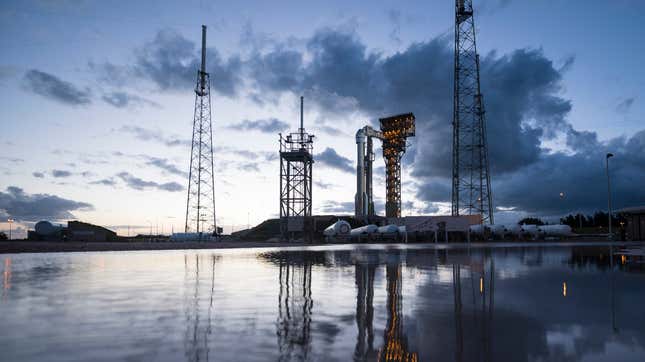
The U.S. Space Force is scheduled to launch its first mission to space in a two-hour window beginning at 2:57 p.m. ET on Thursday from Cape Canaveral, sending a communications satellite into orbit aboard a United Launch Alliance Atlas V rocket.
Per the Orlando Sentinel, the Advanced Extremely High Frequency satellite onboard (AEHF-6) is the last in a $15 billion program and will be used to support the Space Force’s Space and Missile Systems Center, as well as secure communications for the U.S. military and some of its allies. If all goes as planned, the roughly 13,600-pound (about 6,170 kilograms), $850 million AEHF satellite will orbit at around 22,200 miles (about 36,000 kilometers) above the Earth in a geostationary orbit, joining five previous AEHF satellites launched since 2010.
The Space Force, which is technically still organized under the auspices of the Air Force, tested an intercontinental ballistic missile last month; it’s also expected to absorb the Space Development Agency, which is launching a constellation of hundreds of surveillance satellites.
AEHF satellites have low bandwidth but are designed to keep providing communications capabilities against signal jamming or in extreme scenarios like nuclear war; the six in orbit will supposedly provide redundancy in the event another nation tries to shoot them down. Manufacturer Lockheed Martin says they are a major improvement on their predecessor, the 26-year-old Milstar system.
“Individual user data rates will be increased five-fold, permitting transmission of tactical military communications, such as real-time video, battlefield maps and targeting data,” a Lockheed Martin spokesperson told Popular Mechanics. “In addition to its tactical mission, AEHF assures the critical protected communications links for national leaders, such as the President and Joint Chiefs of Staff, in all levels of conflict.”
According to Spaceflight Now, ULA and military officials say that the ongoing coronavirus pandemic has not affected operations and that personnel will practice social distancing to minimize possible exposure. That means between a fifth and a quarter of the personnel normally on hand for a launch will not be physically present. ULA teams are undergoing prep including launch day checkouts and filling the rocket with liquid hydrogen and liquid oxygen propellants, while the launch window has an 80 percent chance of favorable weather, Spaceflight Now reported. The U.S. has seen minimal coronavirus-related delays to its space program in comparison to Europe, which suspended operations at its French Guiana launch center this month.
The Space and Missile Systems Center told SpaceFlight Now in a statement that in addition to AEHF-6, the rocket will carry a small TDO 2 satellite based on a 12U CubeSat that will “support space domain awareness through optical calibration and satellite laser ranging.” It added that TDO 2 will be released approximately 31 minutes after liftoff, while the AEHF-6 satellite won’t be released until around five hours, 41 minutes post launch.
A live broadcast of the launch is available below: